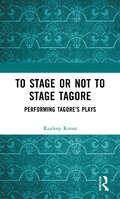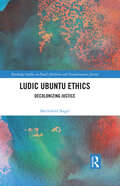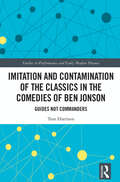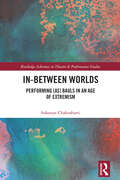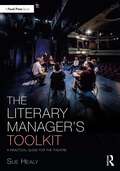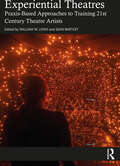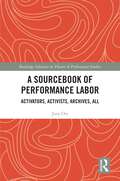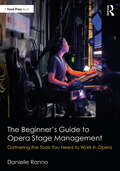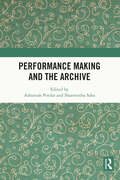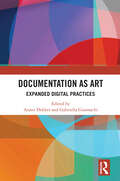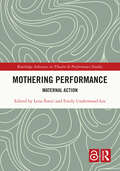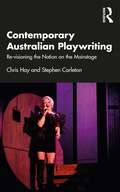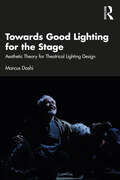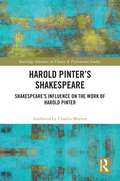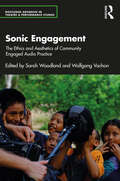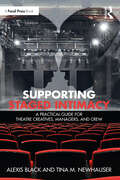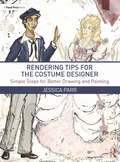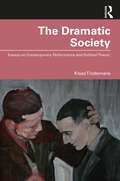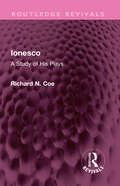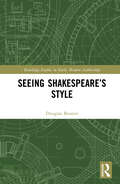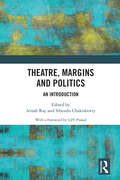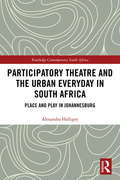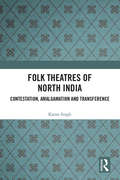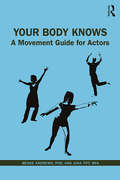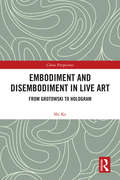- Table View
- List View
To Stage or Not to Stage Tagore: Performing Tagore's Plays
by Rajdeep KonarRabindranath Tagore (1861‒1941) was a prolific playwright with more than thirty plays to his credit. He is also known for his life-long, passionate engagement with theatre, first at Jorasanko and then at Santiniketan, in multiple roles as actor, director, singer, musician. However, during his own life-time and even after his demise, his experimental plays have proved challenging for directors to stage. Time and again they have been written off as unstageable by prominent theatre makers. Further complications have arisen from the presence of a spectre of authority around Tagore and his plays often promoted by Visva-Bharati, the institution he founded and which held the copyright of his works till 2001. This book travels through time and space intending to untangle the enigma presented by Tagore’s plays. The book on one hand immerses itself into the archive of Tagore’s plays and his dramaturgy of them in order to problematize the ways in which they have been interpreted. On the other, it also engages with productions of Tagore’s plays during and after his life-time to understand the challenges directors have faced while staging them and the strategies they have embraced to circumvent them. While performing a subjective critical reading of the Tagore theatre-archive, an underlying objective of the book remains to understand the very concept of the archive, as it manifests itself in contemporary dramatic theatre.
Ludic Ubuntu Ethics: Decolonizing Justice (Routledge Studies in Penal Abolition and Transformative Justice)
by Mechthild NagelLudic Ubuntu Ethics develops a positive peace vision, taking a bold look at African and Indigenous justice practices and proposes new relational justice models. ‘Ubuntu’ signifies shared humanity, presenting us a sociocentric perspective of life that is immensely helpful in rethinking the relation of offender and victim. In this book, Nagel introduces a new theoretical liberation model—ludic Ubuntu ethics—to showcase five different justice conceptions through a psychosocial lens, allowing for a contrasting analysis of negative Ubuntu (eg., through shaming and separation) towards positive Ubuntu (eg., mediation, healing circles, and practices that no longer rely on punishment). Providing a novel perspective on penal abolitionism, the volume draws on precolonial (pre-carceral) Indigenous justice perspectives and Black feminism, using discourse analysis and a constructivist approach to justice theory. Nagel also introduces readers to a post secular turn by taking seriously the spiritual dimensions of healing from harm and highlighting the community’s response. Spanning disciplinary boundaries and aimed at readers seeking to understand how to move beyond reintegrative shaming and restorative justice theories, the volume will engage scholars of criminology, philosophy and law, and more specifically penal abolitionism, social ethics, peace studies, African studies, critical legal studies, and human rights. It will also be of great interest to practitioners and activists in restorative justice, mediation, social work, and performance studies.
Imitation and Contamination of the Classics in the Comedies of Ben Jonson: Guides Not Commanders (Studies in Performance and Early Modern Drama)
by Tom HarrisonThis book focuses on the influence of classical authors on Ben Jonson’s dramaturgy, with particular emphasis on the Greek and Roman playwrights and satirists. This book illuminates the interdependence of the aspects of Jonson’s creative personality by considering how classical performance elements including the Aristophanic ‘Great Idea,’ chorus, Terentian/Plautine performative strategies, and ‘performative’ elements from literary satire manifest themselves in the structuring and staging of his plays. This fascinating exploration contributes to the ‘performative turn’ in early modern studies by reframing Jonson’s classicism as essential to his dramaturgy as well as his erudition. This book is also a case study for how the early modern education system’s emphasis on imitative-contaminative practices prepared its students, many of whom became professional playwrights, for writing for a theatre that had a similar emphasis on the recycling and recombining performative tropes and structures.
In-Between Worlds: Performing [as] Bauls in an Age of Extremism (Routledge Advances in Theatre & Performance Studies)
by Sukanya ChakrabartiThis book examines the performance of Bauls ‘folk’ performers from Bengal, in the context of a rapidly globalizing Indian economy and against the backdrop of extreme nationalistic discourses. Recognizing their scope beyond the musical and cultural realm, Sukanya Chakrabarti engages in discussing the subversive and transformational potency of Bauls and their performances. In-Between Worlds argues that the Bauls through their musical, spiritual, and cultural performances offer ‘joy’ and ‘spirituality,’ thus making space for what Dr. Ambedkar in his famous 1942 speech had identified as ‘reclamation of human personality’. Chakrabarti destabilizes the category of ‘folk’ as a fixed classification or an origin point, and fractures homogeneous historical representations of the Baul as a ‘folk’ performer and a wandering mendicant exposing the complex heterogeneity that characterizes this group. Establishing ‘folk-ness’ as a performance category, and ‘folk festivals’ as sites of performing ‘folk-ness,’ contributing to a heritage industry that thrives on imagined and recreated nostalgia, Chakrabarti examines different sites that produce varied performative identities of Bauls, probing the limits of such categories while simultaneously advocating for polyvocality and multifocality. While this project has grounded itself firmly in performance studies, it has borrowed extensively from fields of postcolonial studies and subaltern histories, literature, ethnography and ethnomusicology, and cosmopolitan studies.
The Literary Manager's Toolkit: A Practical Guide for the Theatre (The Focal Press Toolkit Series)
by Sue HealyThe Literary Manager’s Toolkit is a clear and comprehensive guide to the role of the literary manager in theatre and beyond, focusing on the key skills, networks, and processes that underpin a successful career in this and associated roles. This book outlines the tasks and responsibilities of a literary manager in the selection, development, and production of new plays. In the first part, it outlines the how, when, and why of the literary manager’s main activities, equipping the reader with everything that they will need when approaching this role’s central challenges. The second part provides a selection of practical, accessible, and easy-to-follow materials and workshop suggestions for literary managers who will work with playwrights as they develop their creative writing and dramaturgy skills. This is the go-to resource for the working professional literary manager or dramaturg, and for students on dramaturgy courses in theatre degree programmes.
Experiential Theatres: Praxis-Based Approaches to Training 21st Century Theatre Artists
by William W. Lewis Sean BartleyExperiential Theatres is a collaboratively edited and curated collection that delivers key insights into the processes of developing experiential performance projects and the pedagogies behind training theatre artists of the twenty-first century. Experiential refers to practices where the audience member becomes a crucial member of the performance world through the inclusion of immersion, participation, and play. As technologies of communication and interactivity have evolved in the postdigital era, so have modes of spectatorship and performance frameworks. This book provides readers with pedagogical tools for experiential theatre making that address these shifts in contemporary performance and audience expectations. Through case studies, interviews, and classroom applications the book offers a synthesis of theory, practical application, pedagogical tools, and practitioner guidance to develop a praxis-based model for university theatre educators training today’s theatre students. Experiential Theatres presents a holistic approach for educators and students in areas of performance, design, technology, dramaturgy, and theory to help guide them through the processes of making experiential performance.
A Sourcebook of Performance Labor: Activators, Activists, Archives, All (Routledge Advances in Theatre & Performance Studies)
by Joey OrrA Sourcebook of Performance Labor presents the views and experiences of collaborators in other artists’ works. This book reorients well-known works of contemporary performance and social practice around the workers who have shaped, enacted, and supported them. It emerges from perspectives on maintenance, care, affective labor, and the knowledges created and preserved through gesture and intersubjectivity. This compilation of interviews is filled with the voices of collaborators in notable works attributed to established contemporary artists, including Francis Alÿs, Tania Bruguera, Suzanne Lacy, Ernesto Pujol, Asad Raza, Dread Scott, and Tino Sehgal. In the spirit of the artworks under discussion, this book reinvests in the possibilities for art as a collective effort to explore new ways of finding ourselves in others and others in ourselves. The Sourcebook collection is a contribution for further theorizing a largely unaddressed perspective in contemporary art. This collection will be of great interest to students and scholars in performance studies and art history.
The Beginner’s Guide to Opera Stage Management: Gathering the Tools You Need to Work in Opera
by Danielle RannoThe Beginner’s Guide to Opera Stage Management is the first book to cover theatrical stage management practices specifically for opera productions, providing an invaluable step-by-step guide. Beginning with a brief history of opera and detailing its difference from musical theatre, the book covers stage management best practices through prep, rehearsals, tech, performance, and wrap up. From the moment a manager accepts a contract, right through to archiving paperwork, this essential toolkit covers each step of a stage manager’s journey. Working with a score, reading music, working with singers, conductors, and musicians, basic duties of a stage manager versus an assistant stage manager, and other tasks specific to opera are also included in this comprehensive guide. This book is full of tips and tricks, as well as the good, bad, and ugly stories from opera stage managers, sharing both their experiences and mistakes. This is the perfect how-to book for the professional or emerging stage manager looking to work in opera, or to expand their existing stage management skillset.
Performance Making and the Archive
by Sharmistha Saha Ashutosh PotdarThis book investigates theories and practices shaped by a performance’s relationship to the archive. The contributions in the volume examine how the changing nature of performance practices has made it imperative to understand how the archive and archival practices could add to the performance work. They explore a variety of themes, including artistic engagement with the archive in both conceptual and material terms; physical, virtual and digital forms; publicly and privately collected; oral, written and digital ways; or organized and unorganized collections. Finally, the volume examines how archives are modelled on existing structure and the ways in which they can be brought into discourses and practices of performance making through engagement and contestation. A novel approach to performance theory, this volume will be of great interest to scholars and researchers of performance studies, media and culture studies, studies of technology and art as also literature and literary criticism.
Documentation as Art: Expanded Digital Practices
by Gabriella Giannachi Annet DekkerDocumentation as Art presents documentation as an expanded practice that is radically changing the ways in which to look at, participate in, and generate art. Bringing together expertise from different disciplines, the book provides an in-depth investigation of the development of documentation as a set of production, circulation, and preservation strategies. Illustrating how these are often led by artists, audiences, and museums, the contributions offer new insights into digital art and its history, curation, and preservation, through documentation. Considering documentation as the main method of preserving these art forms, the book analyses how it can address the inherent challenges of capturing live events, visitor experiences, and evolving artworks. Showing how documentation itself can become (part of) an original artwork, the book discusses ways in which these expanded practices can impact the value and experience of the documented event or artwork, giving consideration to how this might affect the traditional authority of the museum as creator of documentation used for future reference, historical relevance, or cultural memory. Documentation as Art demonstrates how the curation and preservation of documentation and the introduction of audience-generated documentation are radically changing exhibition and visiting practices in which documentation is becoming a significant and emergent cultural form in its own right. The book will appeal to researchers and students engaged in the study of museums and curation, art and art history, performance, new media and digital art, library and information science, and conservation.
Mothering Performance: Maternal Action (Routledge Advances in Theatre & Performance Studies)
by Lena Šimić Emily Underwood-LeeMothering Performance is a combination of scholarly essays and creative responses which focus on maternal performance and its applications from a variety of interdisciplinary perspectives. This collection extends the concept and action of ‘performance’ and connects it to the idea of ‘mothering’ as activity. Mothering, as a form of doing, is a site of never-ending political and personal production; it is situated in a specific place, and it is undertaken by specific bodies, marked by experience and context. The authors explore the potential of a maternal sensibility to move us towards maternal action that is explicitly political, ethical, and in relation to our others. Presented in three sections, Exchange, Practice, and Solidarity, the book includes international contributions from scholars and artists covering topics including ecology, migration, race, class, history, incarceration, mental health, domestic violence, intergenerational exchange, childcare, and peacebuilding. The collection gathers diverse maternal performance practices and methodologies which address aesthetics, dramaturgy, activism, pregnancy, everyday mothering, and menopause. The book is a great read for artists, maternal health and care professionals, and scholars. Researchers with an interest in feminist performance and motherhood, within the disciplines of performance studies, maternal studies, and women’s studies, and all those who wish to gain a deeper understanding of maternal experience, will find much of interest.
Contemporary Australian Playwriting: Re-visioning the Nation on the Mainstage
by Stephen Carleton Chris HayContemporary Australian Playwriting provides a thorough and accessible overview of the diverse and exciting new directions that Australian Playwriting is taking in the twenty-first century. In 2007, the most produced playwright on the Australian mainstage was William Shakespeare. In 2019, the most produced playwright on the Australian mainstage was Nakkiah Lui, a Gamilaroi and Torres Strait Islander woman. This book explores what has happened both on stage and off to generate this remarkable change. As writers of colour, queer writers, and gender diverse writers are produced on the mainstage in larger numbers, they bring new critical directions to the twenty-first century Australian stage. At a politically turbulent time when national identity is fractured, this book examines the ways in which Australia’s leading playwrights have interrogated, problematised, and tried to make sense of the nation. Tracing contemporary trends, the book takes a thematic approach to the re-evaluation of the nation that is dramatized in key Australian plays. Each chapter is accompanied by a duologue between two of the playwrights whose work has been analysed, to provide a dual perspective of theory and practice.
Towards Good Lighting for the Stage: Aesthetic Theory for Theatrical Lighting Design
by Marcus DoshiTowards Good Lighting for the Stage: Aesthetic Theory for Theatrical Lighting Design explores the theoretical underpinnings of effective lighting design from conceptualization to live performance. Through an investigation of the author’s own aesthetic point of view—grounded in a broad investigation of art and design that blends pop culture and fine art, theory, and practice—this book documents the author’s thinking on the design process to fill the unexplored gap between an aesthetic philosophy and its expression in composition. Redefinitions of the artist, artwork, and spectator link beauty and artistic efficacy to arrive at a set of principles for assessment that demand that contemporary lighting design surpass utilitarian visibility to become a vital part of the total artwork that is a theatrical production. Inspired by the movements of the broader art and design worlds of the mid-19th century through present day—citing influences as diverse as Jennifer Tipton, Lois Tyson, Dieter Rams, and Dave Hickey—this book charts a course from the artistic team’s dramaturgical work to a solo studio concept to the tech table. Engaging and wide-ranging, Towards Good Lighting for the Stage synthesizes years of cross-disciplinary research and case studies of the author’s own work into provocative reading for practitioners of lighting design, advanced students, and academics, as well as those interested in connecting theatrical practice, aesthetic theory, and visual art.
Harold Pinter's Shakespeare: Shakespeare's Influence on the Work of Harold Pinter (Routledge Advances in Theatre & Performance Studies)
by Charles MortonThis book charts the impact of Shakespeare’s works on Harold Pinter’s career as a playwright. This exploration traces Shakespeare’s influence through Pinter’s pre-theatre writings (1950-1956), to his collaboration with Sir Peter Hall (starting properly at the RSC in 1962 and continuing until 1983), and a late, unpublished screenplay for an adaptation of The Tragedy of King Lear (2000). Adding to studies of playwrights such as Samuel Beckett and James Joyce as significant influences on Harold Pinter’s work, this study aims to highlight the significant and lasting impact that Shakespeare had both formatively and performatively on the playwright’s career. Through exploring this influence, Morton gains not only a greater understanding of the shaping of Pinter’s artistic outlook and how this affected his writing, but it also sheds light on the various forms of Shakespeare’s continued influence on new writing, and what can be gained from this. This study will be of great interest to students and scholars in theatre and performance studies.
Sonic Engagement: The Ethics and Aesthetics of Community Engaged Audio Practice (Routledge Advances in Theatre & Performance Studies)
by Sarah Woodland Wolfgang VachonSonic Engagement examines the relationship between community engaged participatory arts and the cultural turn towards audio, sound, and listening that has been referred to as the 'sonic turn'. This edited collection investigates the use of sound and audio production in community engaged participatory arts practice and research. The popularity of podcast and audio drama, combined with the accessibility and portability of affordable field recording and home studio equipment, makes audio a compelling mode of participatory creative practice. This book maps existing projects occurring globally through a series of case study chapters that exemplify community engaged creative audio practice. The studies focus on audio and sound-based arts practices that are undertaken by artists and arts-led researchers in collaboration with (and from within) communities and groups. These practices include—applied audio drama, community engaged podcasting, sound and verbatim theatre, participatory sound art, community-led acoustic ecology, sound and media walks, digital storytelling, oral history and reminiscence, and radio drama in health and community development. The contributors interrogate the practical, political, and aesthetic potentialities of using sound and audio in community engaged arts practice, as well as its tensions and possibilities as an arts-led participatory research methodology. This book provides the first extensive analysis of what sound and audio brings to participatory, interdisciplinary, arts-led approaches, representing a vital resource for community arts, performance practice, and research in the digital age.
Supporting Staged Intimacy: A Practical Guide for Theatre Creatives, Managers, and Crew
by Alexis Black Tina M. NewhauserSupporting Staged Intimacy: A Practical Guide for Theatre Creatives, Managers, and Crew examines the relationship between staged intimacy, intimacy direction, and those supporting the process during pre-production, rehearsal, and performance. First, this book addresses challenges and trends in staging intimacy, helping backstage and offstage theatre artists recognize the problematic approaches and culture that led to the emerging field of intimacy direction. This text will then provide tools and recommended practices for supporting the creation and maintaining of staged intimacy, enabling team members to enact contemporary protocols concerning advocacy and agency. Finally, this book will educate and empower readers with the necessary skills to prompt change; by providing modern techniques, essential workplace protocols, and achievable action items, this book will transform the way theatre designers, managers, crew, and other creative team members engage with theatrical consent. Supporting Staged Intimacy is written for every pre-professional and professional artist working behind the scenes who wish to better support consensual workplaces, physically intimate stories, and the individuals telling those stories.
Rendering Tips for the Costume Designer: Simple Steps for Better Drawing and Painting
by Jessica ParrRendering Tips for the Costume Designer: Simple Steps for Better Drawing and Painting is a guide for students and costume designers who want to improve their drawing, painting, and rendering skills. The book is divided into three sections – Drawing Tips, Painting Tips, and Linework Tips – and includes detailed step-by-step instructions for chapters such as "How to Draw Faces and Hair," "How to Draw Hands," and "How to Draw Feet and Shoes". This format allows readers to pick and choose which techniques to study, enabling them to focus on the areas that give them the most difficulty. Filled with practical information and over 100 illustrations, this reference guide can be used in conjunction with any figure drawing method or painting media. Within these pages, readers will find the answers to the most common rendering questions: Where do the shadows go? How do I make my figures look less stiff? How do I draw patterned fabric? Rendering Tips for the Costume Designer is an invaluable resource for students in Costume Rendering and Costume Design courses, along with professional costume designers looking to improve their rendering skills.
The Dramatic Society: Essays on Contemporary Performance and Political Theory
by Klaas TindemansAll societies are, by their very nature, dramatic. They present themselves, especially for those who want to look back in time, as a fascinating and confusing whole of theatrical events and constructions. Sometimes the theatre itself succeeds in capturing that fascination and confusion. This book describes the dramatic society in the form of case studies that link politics, history and culture. The Dramatic Society uses selected plays to examine specific moments in history. Its range of subjects are extremely diverse, including Medea as an icon of terrorism, a choreography based upon Shakespeare’s As You Like It, horror movies about the German unification, a truth commission dealing with "human zoos", and the reconstruction of Ai Weiwei’s troubles with the tax authorities. This collection of insightful essays deals with theatrical performances – including happenings, installations and movies – of the past fifty years, with every chapter attempting to link artistic events with politics and political theory, from Hannah Arendt to Slavoj Žižek. This is a revealing assessment of the ways in which drama and politics become intertwined, offering crucial insights for scholars and students of theatre studies, performance studies, contemporary politics and cultural studies.
Ionesco: A Study of His Plays (Routledge Revivals)
by Richard CoeFirst published in 1971, Ionesco is a study of the plays written by the absurdist playwright Eugene Ionesco. Eugene Ionesco’s play La Cantatrice Chauve, first presented in 1950, established him as one of the most provocative leaders of post-war ‘Theatre of the Absurd’. By 1970, his work had been performed by leading actors and companies all over the world. The author attempts to understand this enigmatic playwright and his plays, while trying to explore the reasons behind his quick popularity. This book will be of interest to students of literature, drama, philosophy, and history.
Seeing Shakespeare’s Style (Routledge Studies in Early Modern Authorship)
by Douglas BrusterSeeing Shakespeare’s Style offers new ways for readers to perceive Shakespeare and, by extension, literary texts generally. Organized as a series of studies of Shakespeare’s plays and poems, poetry and prose, it looks at the inner functioning of language and form in works from all phases of this writer’s career. Because the very concept of literary style has dropped out of so many of our conversations about writing, we need new ways to understand how words, phrases, speeches, and genres in literature work. Responding to this need, this book shows how visual representations of writing can lead to a deeper understanding of language’s textures and effects. Beginning with chapters that a beginning reader of Shakespeare can benefit from, its second half puts these tools to use in more in-depth examinations of Shakespeare’s language and style. Although focused on Shakespeare’s works, and the works of his contemporaries, this book provides tools for all readers of literature by defining style as material, graphic, and shaped by the various media in which all writers work.
Theatre, Margins and Politics: An Introduction
by Arnab Ray Sibendu ChakrabortyThis book interrogates the relationship of theatre and the dialectics of centre and the margins. It looks into the exciting world of performance to examine how theatre as an art form is perfectly placed to both perform and critique complex relations of power, politics and culture. The volume looks into how drama has historically served as a stage for expressing and showcasing prevalent social, historical, and cultural contexts from which it has emerged or intends to critique. Including a wide range of performative practices like Dalit theatre, Australian Aboriginal theatre, Western realism and Yoruba theatre, it explores varied lived experiences of people, and voices of subversion, subalternity, resistance and transformation. The book scrutinizes the strategies of representation enunciated through textuality, theatricality and performance in these works and the politics they are inextricably linked with. This book will be of interest and use to scholars, researchers, and students of theatre and performance studies, postcolonial studies, race and inequality studies, gender studies, and culture studies.
Participatory Theatre and the Urban Everyday in South Africa: Place and Play in Johannesburg (Routledge Contemporary South Africa)
by Alexandra HalligeyThis book explores theatre and performance as participatory research practices for exploring the everyday of the city. Taking an inner-city suburb of Johannesburg, South Africa as its central case study, the book considers how theatre and performance might be both useful practical tools in considering the everyday city, as well as conceptual lenses for understanding it. The author establishes an understanding of space as ever evolving and formed through the ongoing relationship between things, human and non-human, and considers how theatre and performance offer useful paradigms for learning about and working with city spaces. As ephemeral, embodied, material artistic practices, theatre and performance mirror the nature of everyday life. The book discusses theatre and performance games and placemaking processes as offering valuable ways of discovering daily acts of place-making and providing insights that more conventional research methods may not allow. Yet the book also considers how seeing daily city life as a kind of performance, a kind of theatre in its own right, helps to further understandings of city spaces as ever evolving through complex webs of relationships. This book will be of interest to academics, academic practitioners and post-graduate students in the fields of theatre and performance studies, urban studies and cultural geography.
Folk Theatres of North India: Contestation, Amalgamation and Transference
by Karan SinghThis book examines folk theatres of North India as a unique performative structure, a counter stream to the postulations of Sanskrit and Western realistic theatre. In focusing on their historical, social and cultural imprints, it explores how these theatres challenge the linearity of cultural history and subvert cultural hegemony. The book looks at diverse forms of theatre such as svangs, nautanki, tamasha, all with conventions like open performative space, free mingling of spectators and actors, flexibility in roles and genres, etc. It discusses the genesis, history and the independent trajectory of folk theatres; folk theatre and Sanskrit dramaturgy; cinematic legacy; and theatrical space as performance besides investigating causes, inter-relations within socio-cultural factors, and the performance principles underlying them. It shows how these theatres effectively contest delimitation of human creative impulses (as revealed in classical Sanskrit theatre) from structuring as also of normative impulses of religion and culture, while amalgamating influences from Western theatre, newly-rising religious reform movements of 19th century India, tantra and Bhakti. It further highlights their ability to adapt and reinvent themselves in accordance with spatial and temporal transformations to constitute an important anthropological layer of Indian society. Comprehensive and empirically rich, this book will be an essential read for scholars and researchers of cultural studies, theatre, film and performance studies, sociology, political studies, popular culture, and South Asian studies.
Your Body Knows: A Movement Guide for Actors
by Jana Tift Meade AndrewsYour Body Knows provides the foundation actors need to move with ease and power. It is a practical guide to movement starting at the very beginning: knowing your body and experiencing how it works. Through the work of F.M. Alexander, Rudolf Laban, and Michael Chekhov, this book offers basic training in movement fundamentals. Its step-by-step process supports the actor's work in any acting or movement training program and as a working professional. The book focuses on three main areas of exploration: Body facts – Know your body and its design for movement. Let go of misinformed ideas about your body. Move more freely, avoid injury, and develop a strong body-mind connection. Movement facts – What is movement? Discover the movement fundamentals that can serve your art. Explore new ways of moving. Creative Inspiration – Connect your body, mind, and imagination to liberate authentic and expressive character movement. Your Body Knows: A Movement Guide for Actors is an excellent resource for acting students and their teachers, promoting a strong onstage presence and awakening unlimited potential for creative expression.
Embodiment and Disembodiment in Live Art: From Grotowski to Hologram (China Perspectives)
by Ke ShiLiveness is a pivotal issue for performance theorists and artists. As live art covers both embodiment and disembodiment, many scholars have emphasized the former and interpreted the latter as the opposite side of liveness. In this book, the author demonstrates that disembodiment is also an inextricable part of liveness and presence in performance from both practical and theoretical perspectives. By applying phenomenological theory to live performance, the author investigates the possible realisation of aesthetic dynamics in live art via re-engagement with the notions of embodiment, especially in the sense provided by philosophers such as Gabriel Marcel and Morris Merleau-Ponty. Creative practices from leading performance artists such as Franko B, Ron Athey, Manuel Vason and others, as well as experimental ensembles such as Goat Island, La Pocha Nostra, Forced Entertainment and the New Youth are discussed, offering a new perspective to re-frame human-human relationships such as the one between actor and spectator and collaborations in live genres In addition, the author presents a new interpretation model for the human-material in live genres, helping to bridge the aesthetic gaps between performance art and experimental theatre and providing an ecological paradigm for performance art, experimental theatre and live art.
